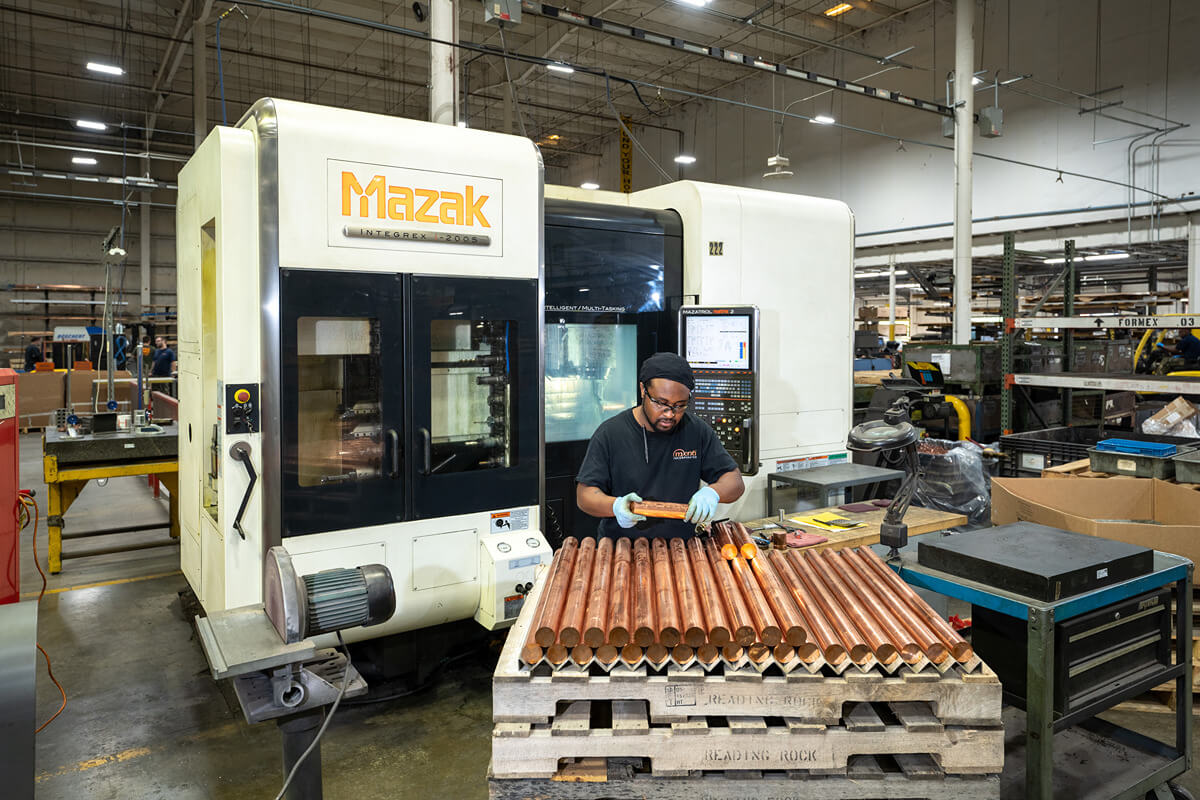Selecting the Ideal Material for Your Sheet Metal Fabrication: Copper vs. Aluminum
Choosing the right material for your sheet metal fabrication project is a critical decision that significantly influences aesthetics, functionality, and durability. At Monti Inc., our sheet metal fabrication materials encompass a range of options, including stainless steel, copper, aluminum, brass, and low, medium, and high carbon steel. While we offer a variety of materials for custom machining, copper and aluminum are two of our most common metals for sheet metal fabrication and CNC machining services.
Exploring the Allure of Copper in Sheet Metal Fabrication
For numerous projects, copper has emerged as the optimal material due to its unique properties. In industries such as electronics and manufacturing, where corrosion-resistant and conductive materials are essential, industry leaders use copper for their high-priority products.
Outstanding Conductivity
Copper is known for its excellent electrical conductivity. This property refers to the ease with which electricity can flow through a material. In the case of copper, its atoms allow electrons to move freely, resulting in minimal electrical resistance to the flow of electrical current.
Efficient Power Transmission
The high conductivity of copper makes it an ideal choice for power transmission applications. When used in electrical wiring, pure copper minimizes energy loss as electricity travels from the source to the destination. This is crucial for maintaining the efficiency of power distribution systems.
Heat Dissipation
Copper’s conductivity extends to heat as well. In addition to efficiently conducting electricity, copper also conducts heat effectively. This property is essential for applications where heat dissipation is a concern, such as in electronic devices. Copper’s ability to transfer heat away from components helps prevent overheating of specific components and overall contributes to the safety of the materials.
Comparison with Other Metals
Pure copper often outperforms other metals like aluminum and stainless steel regarding electrical conductivity. Aluminum wire can be used in electrical applications, however, it is more resistant to electricity, so aluminum conductors are a less desirable alternative to pure copper components. While these metals may be used in certain applications, copper is preferred when electrical performance is a critical factor.
Common Forms in Electrical Components
Copper is commonly shaped into various electrical components, including conductors and wires. These components are utilized in the construction of electrical circuits, providing a reliable and efficient pathway for the flow of electricity.
The exceptional conductivity of copper makes it versatile for a wide range of electrical projects. Whether it’s in the construction of copper wiring in power lines, copper conductors in electronic devices, or electrical systems in buildings, copper’s electrical properties contribute to the reliability and effectiveness of these applications.
Customization and Detailing
Copper’s malleability provides designers and craftsmen with the ability to create intricate and detailed designs. Whether it’s through hammering, engraving, or other forming techniques, copper can be shaped with precision to capture intricate patterns, textures, and fine details.
Flexibility in Achieving Desired Shapes
Designers benefit from the flexibility that copper offers when it comes to achieving specific shapes. The metal can be easily molded and shaped into a variety of forms, allowing for the realization of complex and unique designs. This flexibility is particularly valuable in projects where the end result requires a high level of customization.
Preferred Choice for Unique Shapes
Copper’s malleability makes it a preferred choice for projects that demand unique and unconventional shapes. Whether it’s architectural elements, artistic sculptures, or decorative elements, copper allows designers to push the boundaries of creativity and bring distinctive shapes to life.
Distinctive Finish
The ability to customize copper to intricate details contributes to a distinctive finish in the end products. Items crafted from copper often showcase craftsmanship that sets them apart, providing a unique aesthetic appeal. This distinctive finish can be especially appealing in design-driven industries where individuality and creativity are highly valued.
To preserve the metallic finish of your copper components, you might wish to consider coating the item, as oxidation can impact the aesthetic appearance of your copper products.
Environmentally Friendly
Copper is fully recyclable, which means it can be reused and repurposed without any loss of quality or performance. Unlike some materials that degrade during recycling, copper maintains its integrity through multiple recycling processes. This characteristic enhances the sustainability of copper as a material.
Copper is well-suited for a closed-loop recycling system. This means that it can be recycled indefinitely without losing its essential properties. The closed-loop nature of copper recycling minimizes the need for extracting new copper from primary sources, reducing the environmental impact associated with mining and extraction.
Eco-Friendly Option
The recyclability of copper positions it as an eco-friendly option in various industries. Using recycled copper instead of newly mined copper contributes to resource conservation, energy savings, and a reduction in greenhouse gas emissions associated with producing primary metals. Keeping an environmentally conscious mindset can also help with the purchasing process, especially if your organization is seeking to purchase environmentally mindful products.
Considering Aluminum in Sheet Metal Fabrication
While copper has merits, aluminum also offers distinct advantages in sheet metal fabrication.
Lightweight and Durable
Aluminum is known for its lightweight yet durable nature, making it suitable for various applications. Its strength-to-weight ratio and tensile strength make it an excellent choice when product weight or the weight of materials it connects to is a consideration.
Corrosion Resistance
Aluminum’s inherent corrosion resistance is a standout feature that elevates its suitability for a wide range of applications, particularly in challenging environmental conditions. This quality plays a pivotal role in ensuring the longevity and durability of structures and components, especially those exposed to the rigors of outdoor elements.
Natural Shield Against Corrosion
Aluminum possesses a natural ability to form a protective oxide layer on its surface. This oxide layer acts as a barrier, shielding the metal from corrosive elements in the environment. Unlike other metals that may succumb to rust or corrosion over time, aluminum’s protective layer helps maintain its structural integrity.
Outdoor Applications
The natural corrosion resistance of aluminum makes it a preferred choice for outdoor applications. From architectural structures to outdoor furniture, aluminum components can withstand exposure to rain, sunlight, and varying temperatures without succumbing to deterioration caused by corrosion.
Weathering Harsh Environmental Conditions
Structures or components exposed to harsh environmental conditions, such as coastal areas with high salt content in the air, benefit greatly from aluminum’s corrosion resistance. The metal’s ability to resist corrosion in salt-laden atmospheres makes it valuable for marine applications, including boat construction, aluminum cabling, and offshore structures.
Low Maintenance Requirements
Aluminum’s resistance to corrosion contributes to low maintenance requirements for structures and products made from this metal. The reduced need for protective coatings makes aluminum a cost-effective and efficient choice in situations where maintenance poses logistical challenges.
Highly Versatile
Aluminum’s versatility makes it suitable for various industries, including construction, automotive, and manufacturing. Its strength and corrosion resistance allows it to withstand diverse environments and applications.
Aluminum’s versatility extends into the manufacturing realm, where its formability and machinability cater to a wide range of production processes. Its compatibility with various fabrication techniques, including casting, extrusion, and forging, allows manufacturers to create intricate and customized components for diverse applications.
Cost Effective
In addition to its versatile properties, aluminum stands out as a cost-effective option, often surpassing copper in terms of economic efficiency. This affordability without compromising performance has made aluminum a preferred choice in various industries, bringing substantial benefits to both manufacturers and end-users in terms of cost savings.
Material Costs
One of the primary factors contributing to aluminum’s cost-effectiveness is its lower material cost compared to copper. Aluminum is more abundant in the Earth’s crust, making it a cost-efficient raw material. This affordability translates directly into reduced material expenses for projects and manufacturing processes.
Energy Efficiency in Production
The production of aluminum requires less energy compared to copper. Aluminum’s lower melting point means that less energy is needed during the smelting and manufacturing processes. This energy efficiency not only reduces production costs but also aligns with the broader goal of sustainable and resource-efficient practices.
Availability and Affordability
Aluminum’s widespread availability and cost competitiveness contribute to its affordability. This availability ensures a stable supply chain, reducing the risk of market fluctuations that could impact material prices. Industries seeking cost-effective solutions find aluminum to be a reliable and economical option.
Choosing the Right Material for Your Project
Ultimately, the choice between copper and aluminum depends on your specific project requirements. Copper offers superior electrical conductivity and environmental sustainability, while aluminum excels in being lightweight, corrosion-resistant, versatile, and low-maintenance.
When selecting the right material, consider environmental conditions, aesthetic preferences, functionality, and specific performance requirements. Whether you opt for the timeless allure of copper or the modern resilience of aluminum, Monti Inc. is equipped to bring your vision to life with our expertise in sheet metal fabrication services.
Develop Your Custom Fabrication Project With Monti Inc.
Looking for a partner in custom fabrication? Monti Inc. is your go-to for sheet metal manufacturing. Our state-of-the-art facilities and skilled craftsmen handle stainless steel, copper, aluminum, and more.
When you choose Monti, you can expect top-notch craftsmanship and precision, exceeding your custom project’s expectations. Request a quote to get started on your custom copper or aluminum product.


